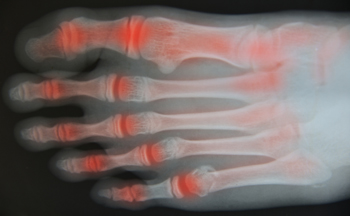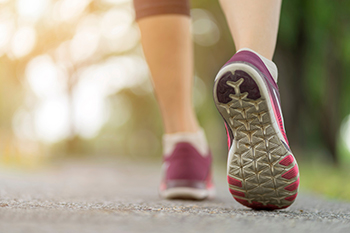

Patients who have arthritis in their feet may benefit from performing specific exercises. It is beneficial to practice each stretch slowly, and stop if any pain is felt. A calf stretch is done by standing on a book that is a few inches away from the wall. A gentle stretch is generally felt while leaning against the wall with straight knees. This can help the calves, heels, and Achilles tendon to become stronger. Mild relief may be felt when the big toe is stretched. This is accomplished by sitting in a chair and crossing one foot over the opposite knee. When the heel is grasped with one hand, the toe is pulled back toward the ankle with the other hand. It is beneficial to hold the stretch for approximately 30 seconds, which is felt on the sole of the foot. If you have arthritis in your feet, there are several exercises and stretches that may help to bring relief. Please consult with a podiatrist who can help you manage this condition.
Arthritis can be a difficult condition to live with. If you are seeking treatment, contact Dale Delaney, DPM from InStride Kinston Podiatry Center. Our doctor can provide the care you need to keep you pain-free and on your feet.
Arthritic Foot Care
Arthritis is a joint disorder that involves the inflammation of different joints in your body, such as those in your feet. Arthritis is often caused by a degenerative joint disease and causes mild to severe pain in all affected areas. In addition to this, swelling and stiffness in the affected joints can also be a common symptom of arthritis.
In many cases, wearing ill-fitting shoes can worsen the effects and pain of arthritis. Wearing shoes that have a lower heel and extra room can help your feet feel more comfortable. In cases of rheumatoid arthritis, the arch in your foot may become problematic. Buying shoes with proper arch support that contour to your feet can help immensely.
Alleviating Arthritic Pain
It is best to see your doctor for the treatment that is right for your needs and symptoms. Conditions vary, and a podiatrist can help you determine the right method of care for your feet.
If you have any questions, please feel free to contact our office located in Kinston, NC . We offer the newest diagnostic tools and technology to treat your foot and ankle needs.

Each year millions of seniors over 65 years old fall, putting them at risk of serious injury, including broken bones or head wounds. Further, experts say that falling once increases a senior’s chances of falling again. It is well known that most falls by seniors happen in or around the home. Fortunately, there are a number of things that can help to prevent falling in your home. Simple changes in the home include removing throw rugs that are easy to trip over and clutter on the floor or hallways. In addition, it is wise to eliminate other tripping hazards, such as wires, boxes, and furniture, from pathways you are likely to use. Fixing steps and walkways that may be uneven, both inside and outside the house, is suggested. Installing adequate lighting or night lights in higher-traffic areas is essential. Adding grab bars in the bathroom and shower areas, and banisters on stairways is recommended. Getting regular light exercise to keep the leg muscles strong is also a good idea. For more information on more ways to prevent falling, please consult a podiatrist.
Preventing falls among the elderly is very important. If you are older and have fallen or fear that you are prone to falling, consult with Dale Delaney, DPM from InStride Kinston Podiatry Center. Our doctor will assess your condition and provide you with quality advice and care.
Every 11 seconds, an elderly American is being treated in an emergency room for a fall related injury. Falls are the leading cause of head and hip injuries for those 65 and older. Due to decreases in strength, balance, senses, and lack of awareness, elderly persons are very susceptible to falling. Thankfully, there are a number of things older persons can do to prevent falls.
How to Prevent Falls
Some effective methods that older persons can do to prevent falls include:
Falling can be a traumatic and embarrassing experience for elderly persons; this can make them less willing to leave the house, and less willing to talk to someone about their fears of falling. Doing such things, however, will increase the likelihood of tripping or losing one’s balance. Knowing the causes of falling and how to prevent them is the best way to mitigate the risk of serious injury.
If you have any questions, please feel free to contact our office located in Kinston, NC . We offer the newest diagnostic and treatment technologies for all your foot care needs.

Foot drop is a condition that makes it difficult to lift the foot high enough to clear the ground when you take a step. As a result, people with foot drop may appear to be high-stepping or marching when they walk. It also may cause you to slap your foot down on the ground with each step. In some cases, the top of the foot or the toes may feel numb. Foot drop is not a disease, but is generally caused by a neurological, muscular, or anatomical problem. The symptoms indicate a weakness or paralysis in the muscles that lift the foot. There are a number of underlying conditions, such as muscular dystrophy, that may be at the root of the problem. Foot drop can be a temporary condition, but if it becomes permanent more advanced diagnostic methods may be recommended. A podiatrist can conduct a number of imaging tests to determine the cause of foot drop. In addition, an ankle foot orthosis may be prescribed to hold the foot in place. Also, electrical nerve stimulation is sometimes helpful. Please consult a podiatrist for more information.
If you have any concerns about your feet, contact Dale Delaney, DPM from InStride Kinston Podiatry Center. Our doctor can provide the care you need to keep you pain-free and on your feet.
Biomechanics in Podiatry
Podiatric biomechanics is a particular sector of specialty podiatry with licensed practitioners who are trained to diagnose and treat conditions affecting the foot, ankle and lower leg. Biomechanics deals with the forces that act against the body, causing an interference with the biological structures. It focuses on the movement of the ankle, the foot and the forces that interact with them.
A History of Biomechanics
Modern technological improvements are based on past theories and therapeutic processes that provide a better understanding of podiatric concepts for biomechanics. Computers can provide accurate information about the forces and patterns of the feet and lower legs.
Understanding biomechanics of the feet can help improve and eliminate pain, stopping further stress to the foot.
If you have any questions please feel free to contact our office located in Kinston, NC . We offer the newest diagnostic and treatment technologies for all your foot and ankle needs.

Babies' feet grow rapidly in their early years. An infant’s foot has 22 bones, and the remaining bones will form by the time the child reaches age five. Prior to this, babies’ feet are made of soft cartilage, and it is important that their first shoe is made of pliable materials. It is beneficial to have your child crawl and walk barefoot while indoors, and this is beneficial in keeping the foot strong. When your child is two years old, they will have a distinctive foot shape, either tapered, square, or round. These shapes are easy to notice, as the toes will be in a square formation when they are all the same length. Many patients’ second or third toe is the longest, and this is characteristic of the rounded shape. When the biggest toe is the longest, this generally falls into the tapered shape category. There are many things to know about children’s foot health, and if you would like additional information, please consult with a podiatrist.
Making sure that your children maintain good foot health is very important as they grow. If you have any questions, contact Dale Delaney, DPM of InStride Kinston Podiatry Center. Our doctor can provide the care you need to keep you pain-free and on your feet.
Keeping Children's Feet Healthy
Having healthy feet during childhood can help prevent medical problems later in life, namely in the back and legs. As children grow, their feet require different types of care. Here are some things to consider...
Although babies do not walk yet, it is still very important to take care of their feet.
Avoid putting tight shoes or socks on his or her feet.
Allow the baby to stretch and kick his or her feet to feel comfortable.
As a toddler, kids are now on the move and begin to develop differently. At this age, toddlers are getting a feel for walking, so don’t be alarmed if your toddler is unsteady or ‘walks funny’.
As your child gets older, it is important to teach them how to take care of their feet.
Show them proper hygiene to prevent infections such as fungus.
Be watchful for any pain or injury.
Have all injuries checked by a doctor as soon as possible.
Comfortable, protective shoes should always be worn, especially at play.
If you have any questions please feel free to contact our office located in Kinston, NC . We offer the newest diagnostic and treatment technologies for all your foot and ankle needs.

If an individual wants to pursue a career in medicine and eventually become a doctor, that individual must typically undergo a rigorous course of study to obtain a degree in medicine. There are doctors of all kinds, and depending on which kind of doctor someone wants to become, they will have to pursue a specialized, specific degree. People that want to become podiatrists, for example, must pursue the degree of Doctor of Podiatric Medicine. This credential is commonly shortened to simply DPM. Podiatrists are very helpful and useful medical professionals that can help you identify and treat a wide range of problems that might be affecting your feet. For example, the DPM might be able to help you treat a case of plantar fasciitis, plantar warts, or toenail fungus, among other things. Schedule an appointment with a podiatrist today for more information.
If you are experiencing pain in the feet or ankles, don’t join the stubborn majority refusing treatment. Feel free to contact Dale Delaney, DPM from InStride Kinston Podiatry Center. Our doctor can provide the care you need to keep you pain-free and on your feet.
What Is a Podiatrist?
Someone would seek the care of a podiatrist if they have suffered a foot injury or have common foot ailments such as heal spurs, bunions, arch problems, deformities, ingrown toenails, corns, foot and ankle problems, etc.
Podiatric Treatment
A podiatrist will treat the problematic areas of the feet, ankle or lower leg by prescribing the following:
A common podiatric procedure a podiatrist will use is a scanner or force plate which will allow the podiatrist to know the designs of orthotics. Patients are then told to follow a series of tasks to complete the treatment. The computer will scan the foot a see which areas show weight distribution and pressure points. The podiatrist will read the analysis and then determine which treatment plans are available.
If you have any questions please feel free to contact our office located in Kinston, NC . We offer the newest diagnostic and treatment technologies for all your foot and ankle needs.